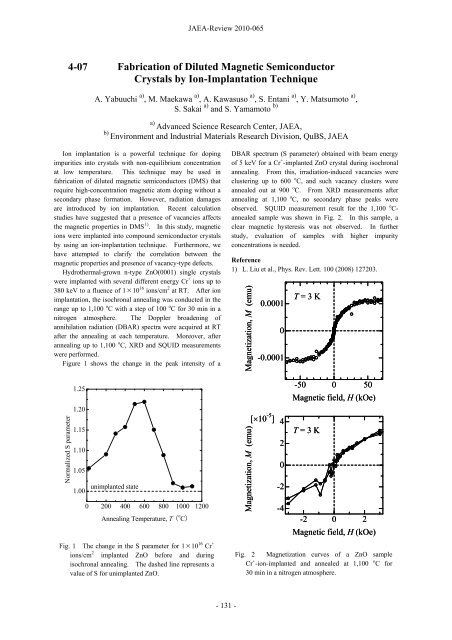JAEA-Review-2010-065.pdf:15.99MB - 日本原子力研究開発機構
JAEA-Review-2010-065.pdf:15.99MB - 日本原子力研究開発機構
JAEA-Review-2010-065.pdf:15.99MB - 日本原子力研究開発機構
Create successful ePaper yourself
Turn your PDF publications into a flip-book with our unique Google optimized e-Paper software.
Fabrication of Diluted Magnetic Semiconductor<br />
Crystals by Ion-Implantation Technique<br />
A. Yabuuchi a) , M. Maekawa a) , A. Kawasuso a) , S. Entani a) , Y. Matsumoto a) ,<br />
S. Sakai a) and S. Yamamoto b)<br />
a) Advanced Science Research Center, <strong>JAEA</strong>,<br />
b) Environment and Industrial Materials Research Division, QuBS, <strong>JAEA</strong><br />
Ion implantation is a powerful technique for doping<br />
impurities into crystals with non-equilibrium concentration<br />
at low temperature. This technique may be used in<br />
fabrication of diluted magnetic semiconductors (DMS) that<br />
require high-concentration magnetic atom doping without a<br />
secondary phase formation. However, radiation damages<br />
are introduced by ion implantation. Recent calculation<br />
studies have suggested that a presence of vacancies affects<br />
the magnetic properties in DMS 1) . In this study, magnetic<br />
ions were implanted into compound semiconductor crystals<br />
by using an ion-implantation technique. Furthermore, we<br />
have attempted to clarify the correlation between the<br />
magnetic properties and presence of vacancy-type defects.<br />
Hydrothermal-grown n-type ZnO(0001) single crystals<br />
were implanted with several different energy Cr + ions up to<br />
380 keV to a fluence of 1 × 10 16 ions/cm 2 at RT. After ion<br />
implantation, the isochronal annealing was conducted in the<br />
range up to 1,100 o C with a step of 100 o C for 30 min in a<br />
nitrogen atmosphere. The Doppler broadening of<br />
annihilation radiation (DBAR) spectra were acquired at RT<br />
after the annealing at each temperature. Moreover, after<br />
annealing up to 1,100 o C, XRD and SQUID measurements<br />
were performed.<br />
Figure 1 shows the change in the peak intensity of a<br />
Normalized S parameter<br />
4-07<br />
1.25<br />
1.20<br />
1.15<br />
1.10<br />
1.05<br />
1.00<br />
unimplanted state<br />
0 200 400 600 800 1000 1200<br />
Annealing Temperature, T ( o C)<br />
Fig. 1 The change in the S parameter for 1 × 10 16 Cr +<br />
ions/cm 2 implanted ZnO before and during<br />
isochronal annealing. The dashed line represents a<br />
value of S for unimplanted ZnO.<br />
<strong>JAEA</strong>-<strong>Review</strong> <strong>2010</strong>-065<br />
- 131 -<br />
DBAR spectrum (S parameter) obtained with beam energy<br />
of 5 keV for a Cr + -implanted ZnO crystal during isochronal<br />
annealing. From this, irradiation-induced vacancies were<br />
clustering up to 600 o C, and such vacancy clusters were<br />
annealed out at 900 o C. From XRD measurements after<br />
annealing at 1,100 o C, no secondary phase peaks were<br />
observed. SQUID measurement result for the 1,100 o C-<br />
annealed sample was shown in Fig. 2. In this sample, a<br />
clear magnetic hysteresis was not observed. In further<br />
study, evaluation of samples with higher impurity<br />
concentrations is needed.<br />
Reference<br />
1) L. Liu et al., Phys. Rev. Lett. 100 (2008) 127203.<br />
Magnetization, M (emu)<br />
Magnetization, M (emu) (emu)<br />
0.0001<br />
0<br />
-0.0001<br />
)<br />
[10 -5 [10 ]<br />
-5 ]<br />
4<br />
2<br />
0<br />
-2<br />
-4<br />
T = 3 K<br />
-50 0 50<br />
Magnetic field, H (kOe)<br />
T = 3 K<br />
-2 0 2<br />
Magnetic field, H (kOe)<br />
Fig. 2 Magnetization curves of a ZnO sample<br />
Cr + -ion-implanted and annealed at 1,100 o C for<br />
30 min in a nitrogen atmosphere.

















